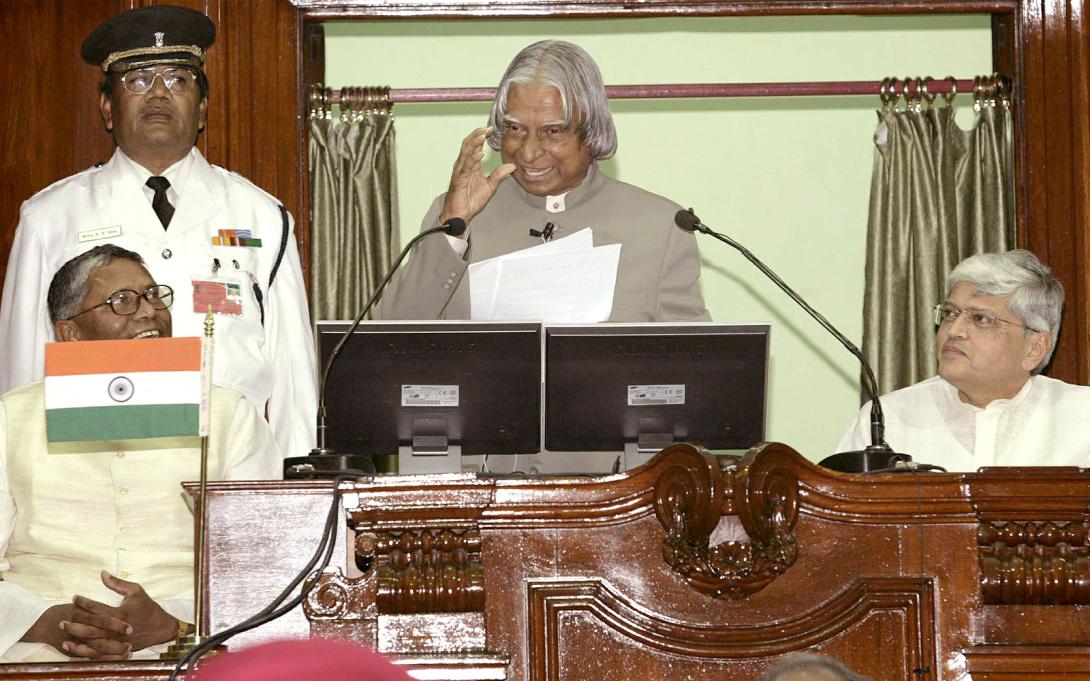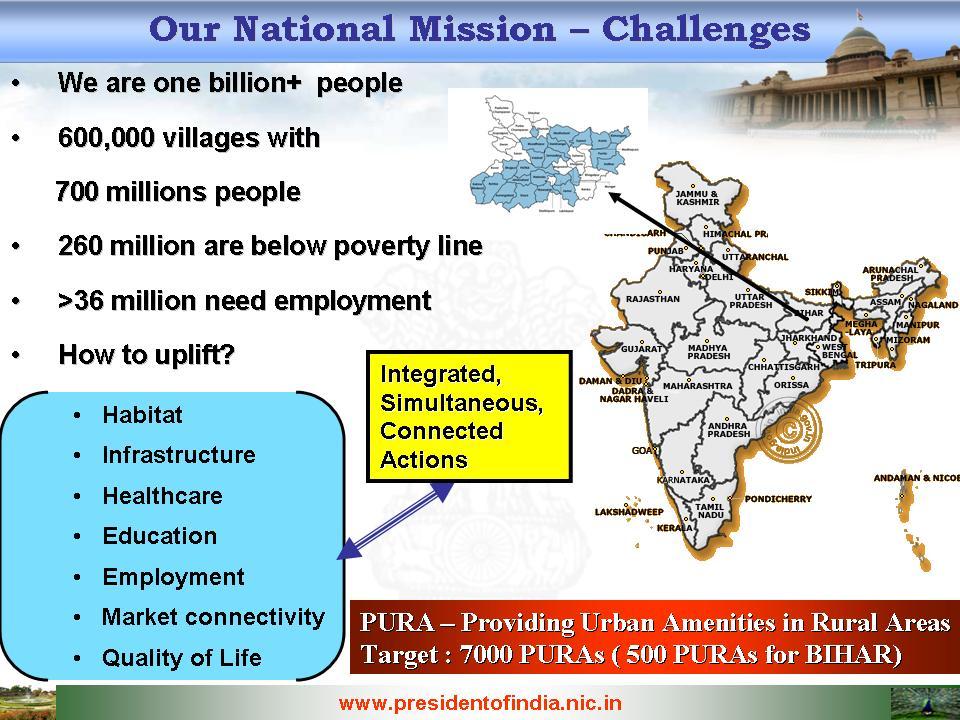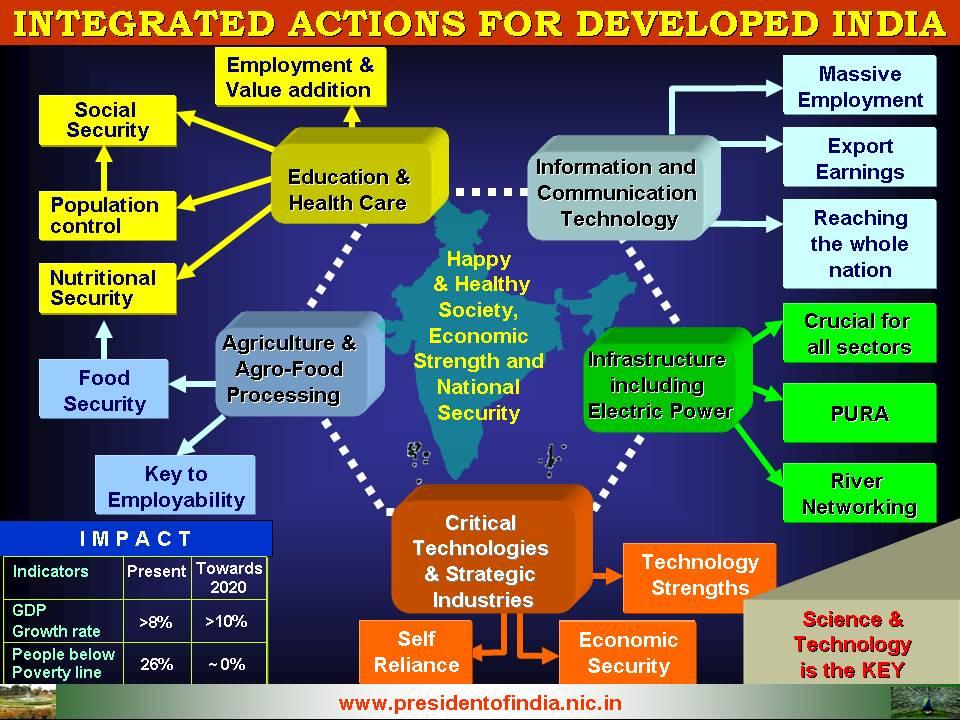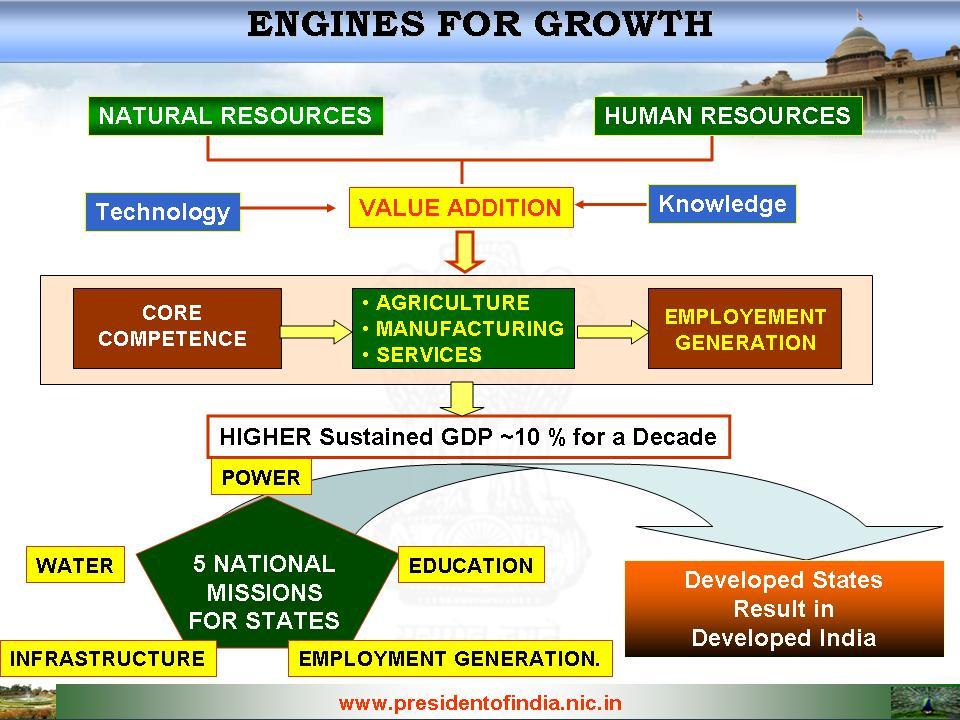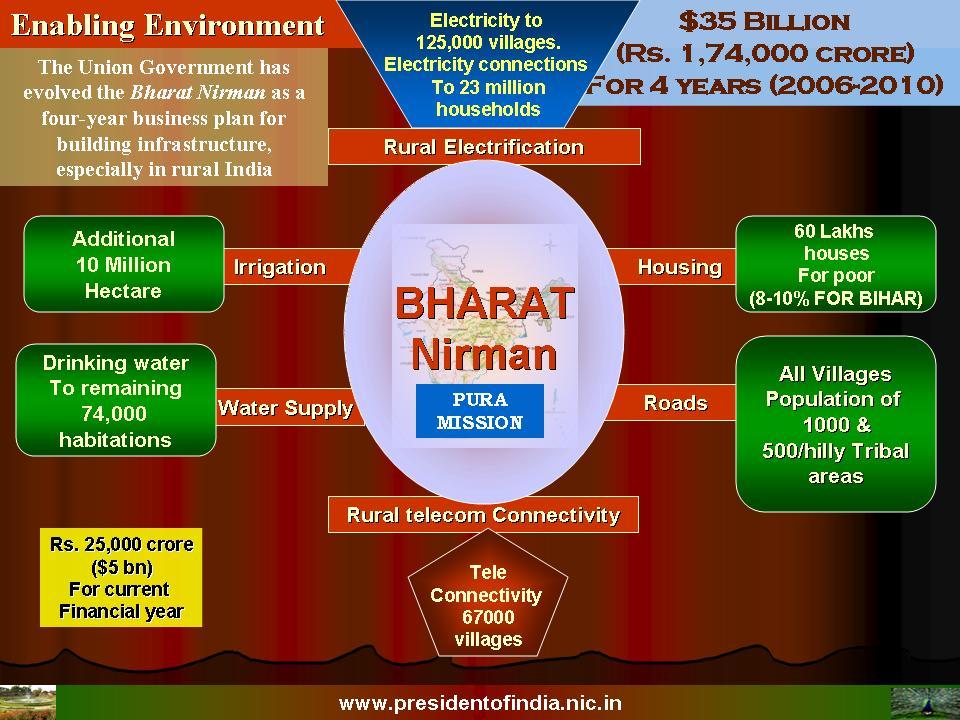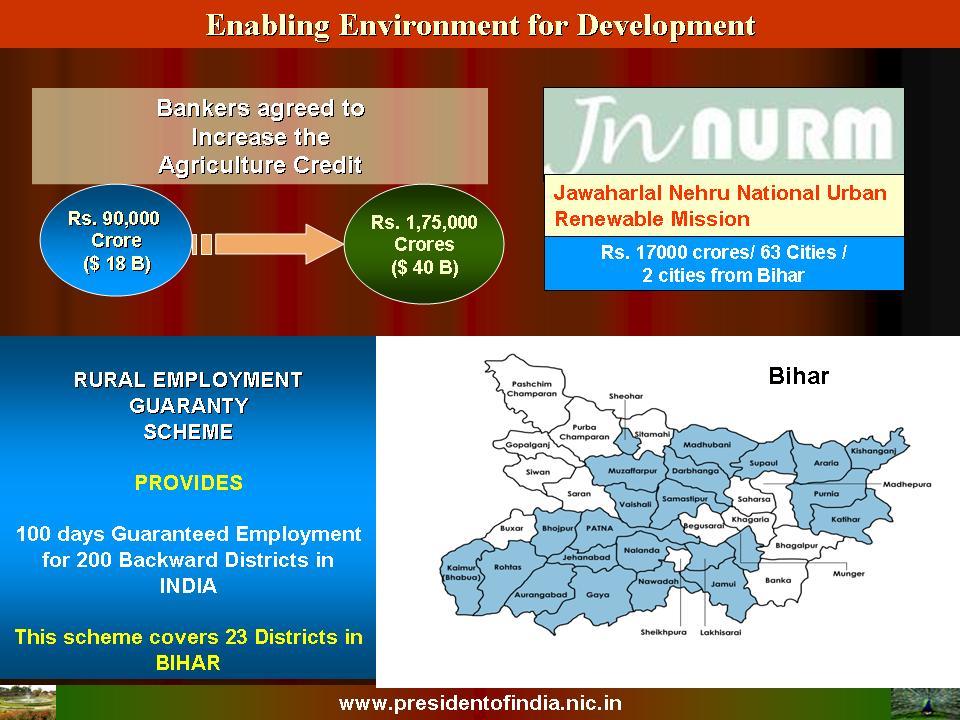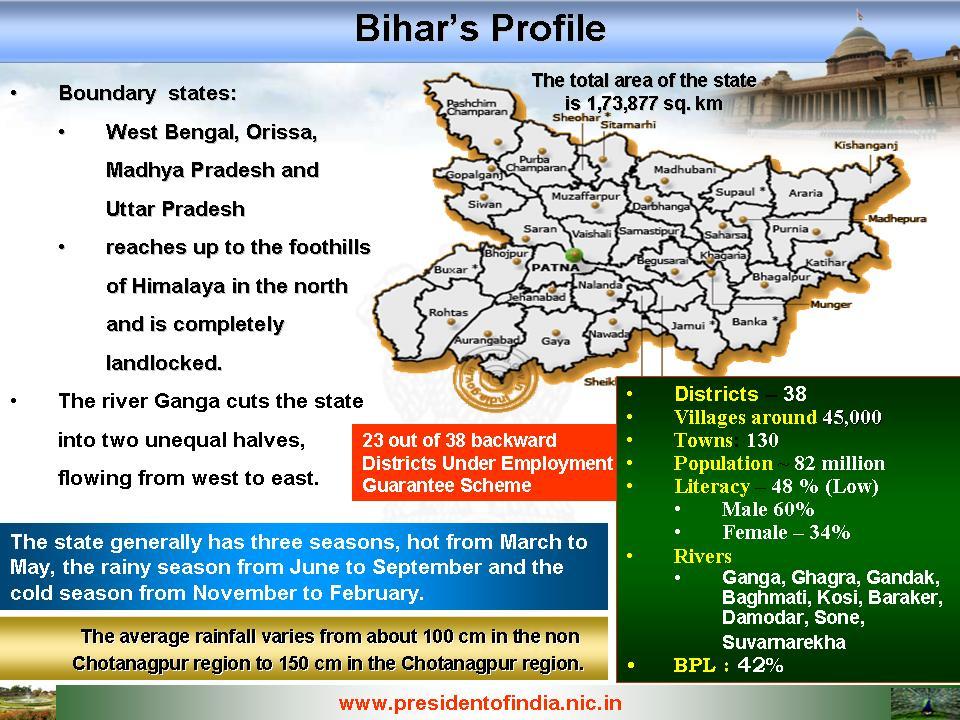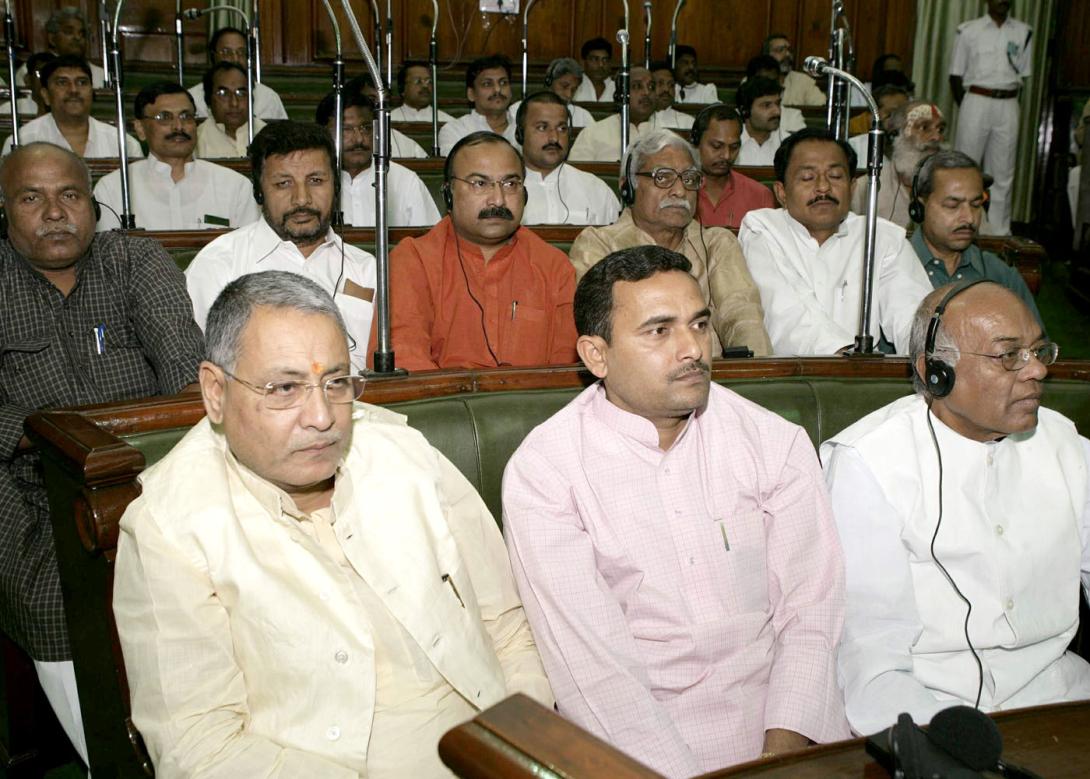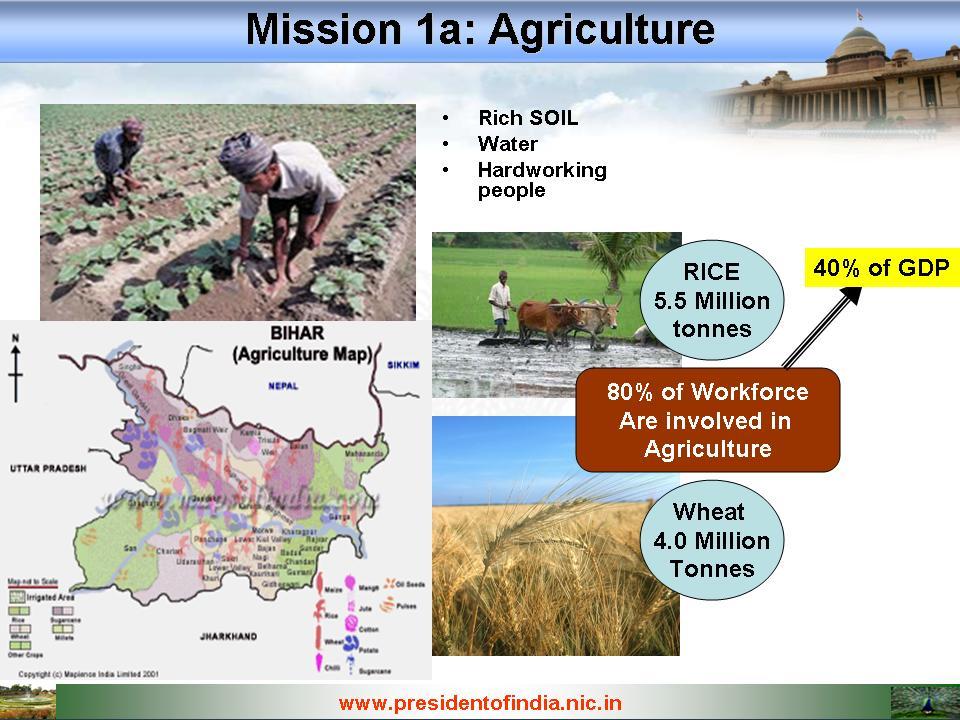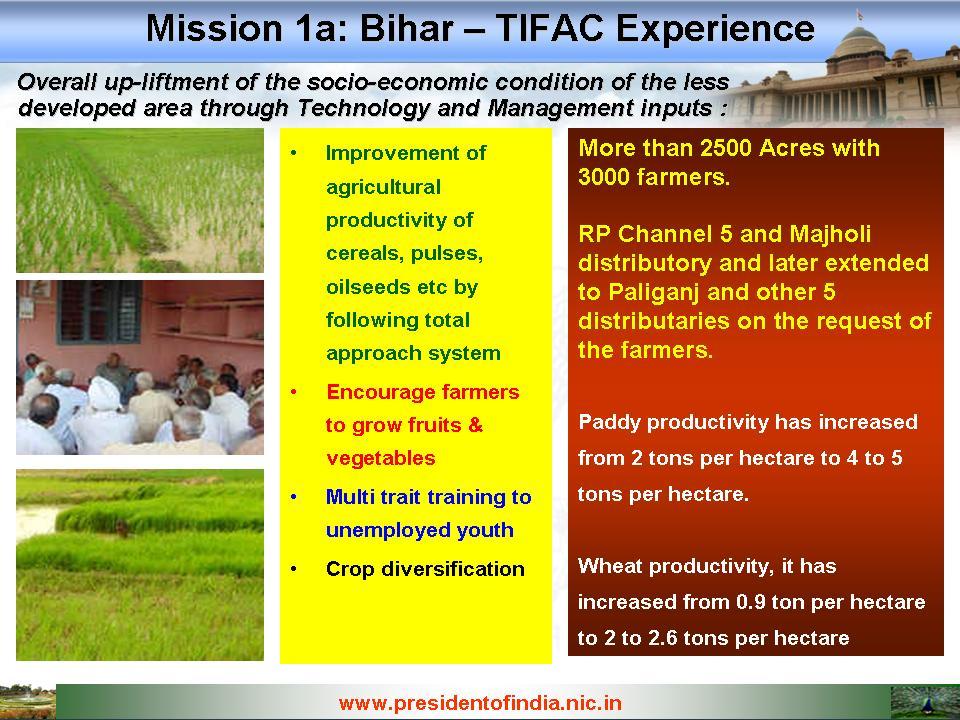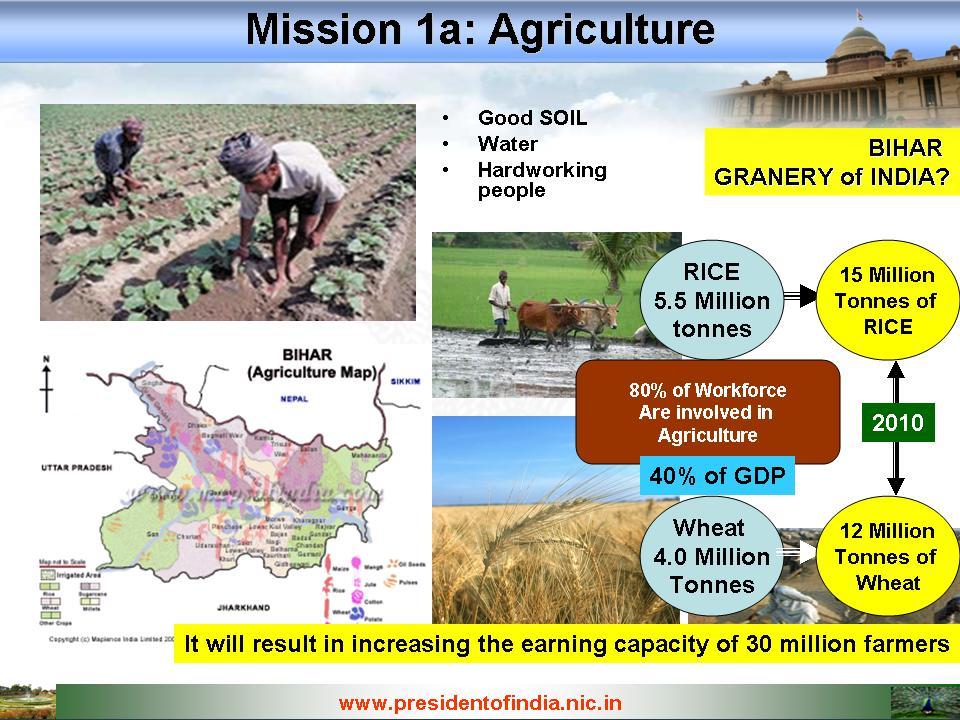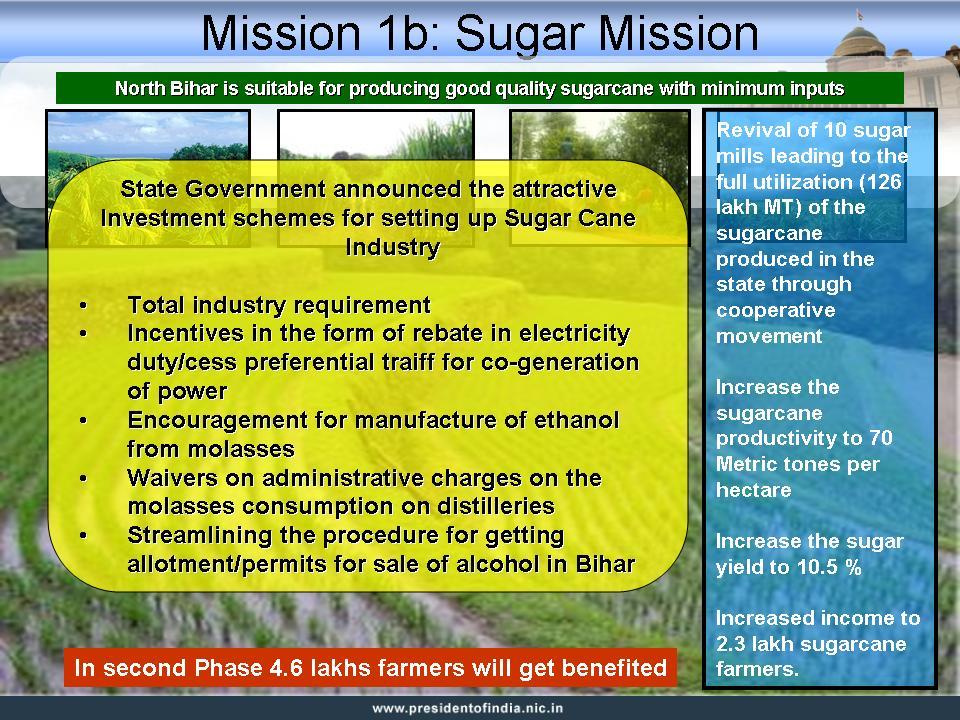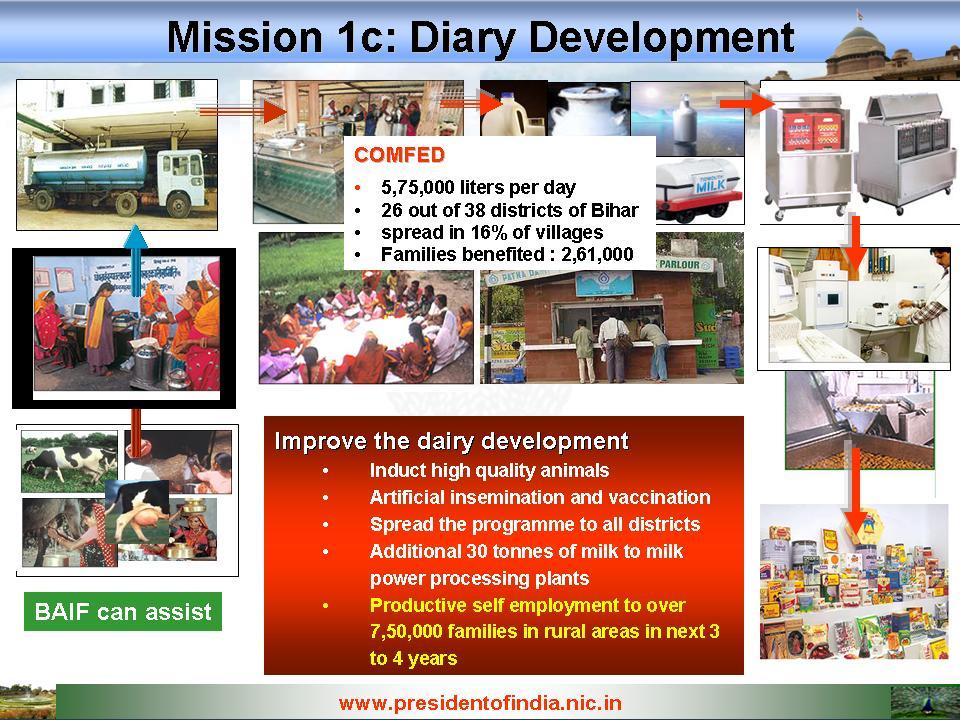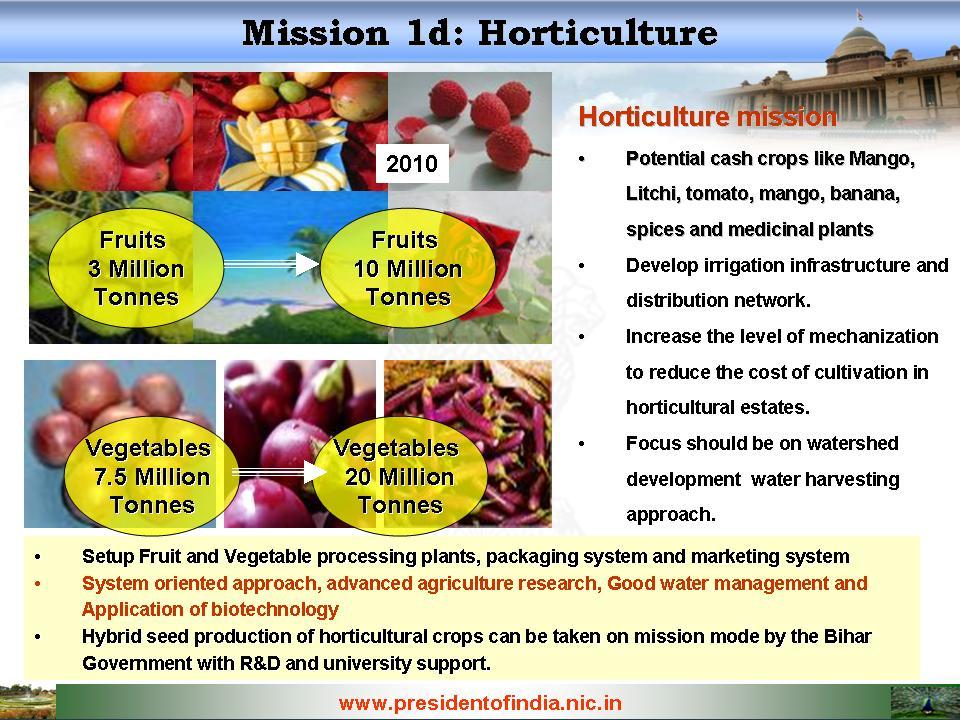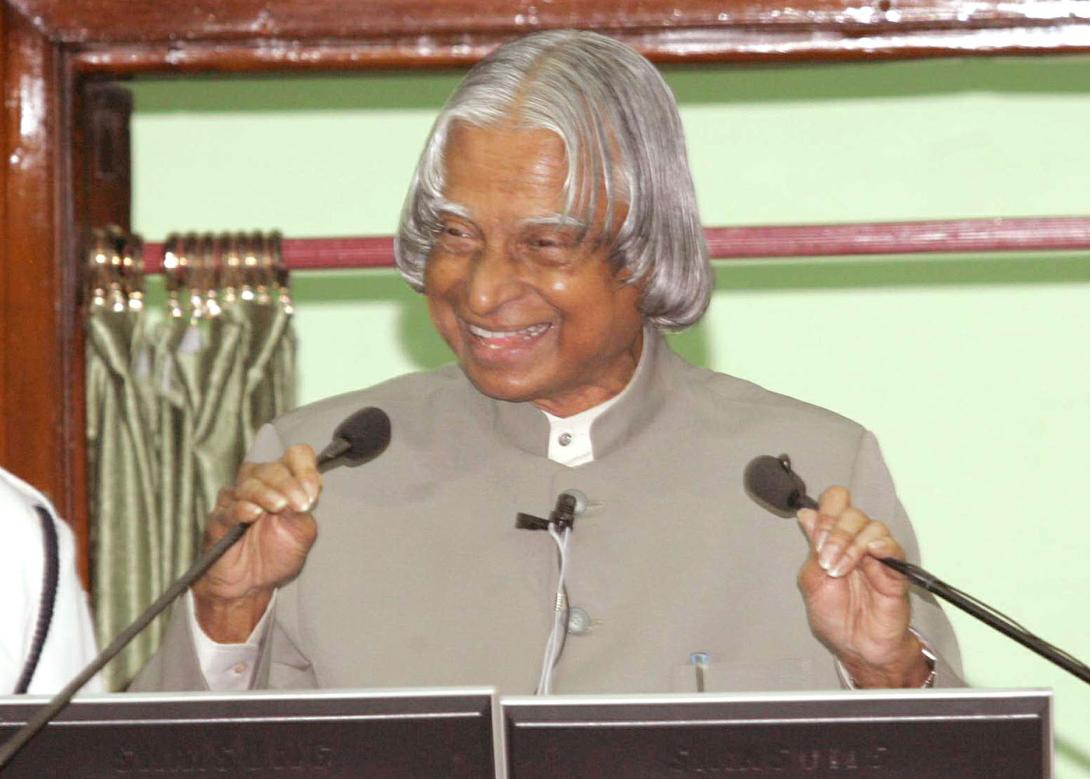Address To The Joint Session Of The Bihar Legislature, Patna
Patna : 28-03-2006
Missions for Bihar's Prosperity
"When you are inspired by some great purpose...
Dormant forces, faculties and talents become alive."

I am delighted to be once again in Patna and to have the opportunity to address the Hon'ble Members of the Legislative Assembly and Legislative Council of Bihar. You are all members of a great institution that gives vision to the state and evolves the legal framework, the policies and programmes of the State. You oversee the financial resources and implementation of major tasks. You have a proud history, the first President of India Dr. Rajendra Prasadji had addressed you and Bihar is his home land. Your mission is to make the aspirations and dreams of people of this state become a reality. My greetings to all of you.
Bihar and me
Dear friends, when I am in Bihar, I would like to narrate three incidents which are important to us. The first one relates to my visit to Mauritius this month. There I met the President of Mauritius Mr. Anerood Jugnauth and the Prime Minister Dr. Naveen Chandra Ramgoolam, both of their ancestors came from Bihar. Also during my trip, I have met at least six cabinet ministers and was delighted to learn that five of these Ministers' and ancestors came from Bihar. Among the 1.2 million people of Mauritius, the forefathers of a large number of those who are presently citizens of Mauritius hailed from Bihar. This is an important connectivity for the people of Bihar and Mauritius. The people of Mauritius are very proud of their origin. Hindi and Bhojpuri are very much alive with the people there. The people of Bihar indeed are enterprising; wherever they go they enriched the land; that means you have an inherent capability to nurture and blossom. People of Bihar have the potential to take up the challenges and succeed. Bihar Legislative Assembly and the Council need to empower the people to realize the missions.
As soon as I took over as the President of India, from the old records I saw a study report from Dr. Paul H. Appleby of University of California. Dr. Appleby was a US based public administration scholar who presented to the then Prime Minister Jawaharlal Nehru in 1952, a document on administration of Indian States. Dr. Appleby's study using various criteria and interviews with hundreds of specialists from across the country concluded that the Bihar was the best administrated state in the country at that time. This is the second interesting anecdote that came to my mind when I was preparing my talk to the Hon'ble Members of the Bihar Legislature.
The third one relates to a recent visit of Dr. Bum Il Kim, President of the World Canaan Farmers Movement Corporation in South Korea to Rashtrapati Bhavan a month ago. He knocked at my door and told me that he has a great attachment towards Bihar and would like to develop agriculture and create related industries there. When I met him, he had a roadmap for the development of agriculture in Bihar. He had detailed maps of cultivable land and water resources. His plans to enhance agriculture productivity in the State to a maximum and his commitment to the same gave me the confidence that the day when Bihar will be the rice bowl of India is not far off.
I am meeting hundreds of important people from India and abroad month after month. No one so far has taken the cause of development of Bihar with such a great passion and clarity. Here is a scientist, here is a professor who is willing with full of enthusiasm and he suggested that his institution in Seoul is open for Bihar, and he will bring many partners from Korea to assist in the development process. I immediately called the Chief Minister and he agreed for a meeting in February itself. I would like to quote an interesting sentence from the e-mail which I received from Dr. Kim: High-profile academicians of South Korea, especially from Yonsei University and Kangwon National University, are preparing presentations on 'Developmental strategies, momentums, policies and major decisions in South Korea to develop Bihar'.
I was impressed that in a week's time, Dr. Bum Il Kim met me, met the Chief Minister and visited the A.K. Sinha Institute of Social Studies. He then went back to Korea and discussed with the specialists there and brought the plan of action for development. I am still trying to see what in Bihar motivated and inspired this Professor. The holiness that gets attached to this land of Buddha can be a great magnet to attract many more Dr. Kims. He reminded me of the late Prof S.K. Sinha who had worked closely with me at Technology Information Forecasting and Assessment Council (TIFAC) to develop the Agriculture Vision 2020 and actually take it to Bihar and show successful results. These efforts had bonded me with Bihar. It is important that the Legislators, who are present here, make the environment conducive to receive such ideas and contribute to the development of Bihar.
Now friends, with these three messages, definitely we should move forward with determination irrespective of challenges to make Bihar an economically prosperous State. This is what I am going to talk to you today. Bihar is an important state in the Indian Union. For India's development, Bihar's development is crucial and very critical. I would like to share a few thoughts with the Hon'ble Members of Bihar Legislative Assembly and Council on: "Missions for Bihar's Prosperity".
Our National Mission - Challenges
Our nation is going through a major challenge of uplifting of 260 million people who are below the poverty line. They need habitat, they need food, they need health care, and they need education and employment finally resulting in a good life. Our GDP is growing at nearly 8% per annum. Whereas, the economists suggest that to uplift the people from below the poverty line, our economy has to grow at the rate of an additional minimum of 3% per annum consistently, for over a decade.
Integrated Action for Development
Our mission of transforming India into a Developed Nation, is to meet the needs of one billion people. We have identified five areas where India has core competencies for integrated action: (1) Agriculture and food processing (2) Infrastructure for all parts of the country such as reliable and quality electric power and surface and air transport (3) Education and Healthcare (4) Information and Communication Technology (5) Self-reliance in Strategic sectors. These five areas are closely inter-related and when effectively addressed, would lead to food, economic, energy and national security and lead to sustainable prosperity.
Engines for Growth
Emphasis should be on full utilization of natural and human resources of the region to meet the demands of modern society. We should also remember that about 50% of our population consists of young people, with aspirations for a better life. Value addition to Agriculture, Manufacturing and Service sectors of the economy, building on the regions' core competencies and technologies, will lead to higher incomes and employment opportunities and therefore higher growth rates. The engines for growth will be launching of the five national missions viz. water, energy, education and skills, infrastructure and employment generation. Developed states result in developed India.
One of the questions that the members may ask is how can we generate the funds required for all the schemes which I would like to share. I would say that the Government has the Bharat Nirman Programme with an outlay of Rs. 1,74,000 Crore, Jawaharlal Nehru National Urban Renewal Mission covering 63 cities with an investment of Rs. 17000 crores, Employment guarantee scheme for 23 out of 38 Districts of Bihar and increase of the bank credit for agriculture to Rs. 1,75,000 Crore. during the year 2006-07. There is a definite share of these funds available for the development of Bihar. The members of the Bihar Assembly, the bureaucratic and the administrative system have to ensure that funds are sought in time and they are fully utilized for the purpose for which they have been allotted. If that takes place I can assure you that there will be no shortage of funds for the development of Bihar.
Now, I would like to discuss about the core competence of Bihar.
Core competence of Bihar
Bihar is the ninth largest state in terms of area in the Indian Union. The total area of the state is 1,73,877 sq. km. The state is completely landlocked. The Ganga river cuts the state into two unequal halves, flowing from West to East. The southern half is almost double in size of the northern part.
Chhotanagpur plateau is full of highlands, hills and valleys. This region is also noted for waterfalls on some rivers like Suvarnarekha (Hundru falls). In northern Bihar there are rivers like Ganga, Kosi, Gandak, Sone, whereas the rivers in the south Bihar are Punpun, Phalgu, Sakri, Kiul, Damodar, Baraker, Suvarnarekha, Koel etc. Most of the rivers merge with the Ganga. The monsoon reigns supreme here and carries great weight in the overall human occupancy pattern and economic development. The average rainfall varies from about 100 cm in the non Chhotanagpur region to 150 cm in the Chhotanagpur region. You are blessed with abundance of water. What is needed is water management through connectivity.
Developed Bihar leads to Developed India
What can be the missions for the development of Bihar? Since the number of people living below poverty line in Bihar is about 42% against the national average of 26%, the first mission is to elevate all of them and bring income into their hands and smiles on their faces. This can be done by having focused development leading to higher per capita income and better quality of life. Your state can definitely transform into an economically developed model state. At this stage, let me share with you the Development Radar brought out by the Planning Commission.
The boundary of octagon projected in the Development Radar indicates the maximum achievements of various indicators of development. The smaller octagon represents the national average. While we appreciate you for your achievements in safe water provisioning, you need to achieve higher results in the area of pucca houses, literacy, formal education, life expectancy, infant mortality rate, per captia expenditure and poverty alleviation. The Hon'ble Members need to realize that Bihar has the potential to achieve all these aspects better than other states in the country, if only all of you decide to work in synchronization for the development of the state as the prime focus of your two legislatures. It is essential to realize that the development of Bihar is bigger than us individual and even these great Legislatures. The thought of developing Bihar should not be hindered by artificial barriers of politics, religion, region and caste.
Focus Bihar
I am happy to learn that the Government of Bihar is already on the path of evolving a road map for its full fledged development. My presentation to this Joint Session will focus on how the per capita income of Bihar can be increased from the existing Rs. 6,300 (2005-2006) to Rs. 35,000 by 2010 and also to create an investment friendly climate leading to employment avenues. As per the employment exchange report from Bihar as on 31st December 2005, the total registered candidates are 14.7 lakhs. This is pertinent mainly to the urban areas and that too mostly to those who have passed Board exams or beyond. But, 90% of the people live in rural areas and many youth who in the cities who do not pass the Board exams are called dropouts. Hence in our estimates there are at least Ten million unemployed or underemployed persons in the whole of the state. Bihar should aim at realizing the goal of 100% literacy and employment by the year 2015.
The Human Development Index ranking of Bihar within Indian states is fifteen, which should be improved considerably to be in tune with the heritage, past glory and the present aspirations. When your present meets your past and creates the future, Bihar will be transformed into a dream developed state.
Missions for Bihar
Let us study what are the missions which Bihar can undertake based on the core competence of the state. The following are some of the important missions for Bihar's prosperity:-
1. Agriculture and Related Missions
Agriculture is the core competence of Bihar. It has very good soil; abundant supply of irrigation water and very hard working people, in spite of this agriculture has been performing poorly in the last decade leading to low per capita output. This need not discourage us from making a bold attempt to face the challenge and improve the situation. There have been excellent success stories in Bihar itself, which I would like to, narrate. An experiment has been carried out by the TIFAC team in Bihar, in the RP Channel 5 and Majholi distributory and later extended to Paliganj and other 5 distributaries on the request of farmers. The productivity of paddy has increased in these villages from 2 tons per hectare to 5.8 tons per hectare and in respect of wheat productivity; it has increased from 0.9 ton per hectare to 2.6 tons per hectare. Presently, paddy and wheat crops are spread in an area greater than 2500 hectares involving 3000 farmers.
This project has been carried out by the TIFAC, in collaboration with a farmer's co-operative society, Indian Agricultural Research Institute (IARI) and the agricultural university in Pusa, Bihar. Using scientific method of farming involving soil characterization, matching the right seed to soil, seeding in time, fertilizer and pesticide selection, water management, pre and post harvesting methodology productivity has been more than doubled. Our efforts should be to adopt this system oriented approach in all 38 districts of Bihar which will enable Bihar to triple its output of paddy and wheat crops. The aim should be to increase rice production from 5.5 million tonnes to 15 million tonnes and wheat production from 4 million tonnes to 12 million tonnes in four years time. That will make Bihar a Grand Granary of India. In order to achieve this target, the factors which needs to be addressed are: State wide implementation of flood control measures by creating water ways between rivers flowing within the state from South to North and also reducing water-logging in some areas, improvement in infrastructure particularly good motorable roads, assured availability of power to the farmer - through solar power; storage systems in large metric tonnes capacities;
food processing plants; input and output quality assurance centers for seeds and food grains; and marketing centers. Moving up the value chain in agriculture through food processing is essential in the state of Bihar to increase the contribution of the agriculture work force to GDP. This will result at a minimum in doubling the earning capacity of the nearly 25 million farm workers of Bihar. Bihar should become the theatre of action for India's Second Green Revolution. A partnership is essential with ICAR, International Rice Research Institute, Manila and motivated specialist likes Dr. Bum Il Kim.
Sugar Mission: The North of Bihar is agro-climatically very suitable for producing good quality sugarcane with minimum inputs as compared to other states. This should be used to the best advantage of the state. Sugar Cane Research Institute, Pusa or other Sugar Institutions have to work together to develop new varieties of sugar cane to meet the climatic and soil requirements of Bihar. Their research and development must enable the increase the productivity of the sugar cane.
A large number of existing sugar mills under the state run, Bihar Sugar Corporation have to be closed down due to old and obsolete equipment and inadequate skills, as modernization of the existing plant and equipment and re-training of personnel had not been undertaken by these sugar mills. Capacity of the existing remaining sugar mills is also very low compared to national average. I understand that the State Government has announced investment scheme for expansion of capacity of existing sugar industries, to setup new sugar industry and distilleries. This should make a favourable impact on the growth of the Sugar industry in Bihar and the scheme should be implemented in a time bound manner. What we need is to look at the total industry requirement and provision of incentives in the form of rebate in electricity duty / cess preferential tariff for co-generation of power, encouragement for manufacture of ethanol from molasses, waivers on administrative charges on the molasses consumption on distilleries and streamlining the procedure for getting allotment / permits for sale of alcohol in Bihar. This revival of the sugarcane and sugar industry can definitely become a wealth and employment generator for Bihar. The present sugar cane production of the state is around 126,000 metric tonnes, out of which 100,000 metric tonnes is being sent to other states. I would recommend the creation of sugar co-operatives on the lines of the sugar co-operatives presently available in Maharashtra who can establish at least 10 sugar mills which can fully use the existing production of sugarcane for conversion of sugar. There also is a need to enhance the productivity of sugar to at least the level of national average of 70 MT per hectare. This will enable generation of increased income for 2.3 lakh sugarcane farmers. In the second phase we can also consider doubling the area under sugarcane progressively to 4.6 lakh hectares. This system will enable a coherent integration of sugarcane producers in the State and sugar mills leading to higher revenue for farmers. The funding for the new co-operative can come partially as Government grant, equity funds of co-operative members and bank credit through NABARD. In addition, there is a need to create an institution like Vasantdada Sugar Institute, Pune for carrying out continuous research for improving sugarcane productivity and improving the quality and quantity of sugar yield from sugar mills.
Dairy Development: Bihar has a successful model of Dairy development through Bihar State Co-operative Milk Producers Federation. Presently, the Federation is procuring milk to an extent of 5,75,000 liters per day. However, I find that the programme covers only 26 out of 38 Districts of Bihar and spread only in 16% of the villages. The number of families benefiting from this scheme is just 2,61,000. Dairy has a great potential in Bihar. We should attempt to improve the dairy development programme by inducting high quality animals followed by artificial insemination and vaccination programmes. The aim should be to spread the programme to all the districts of Bihar and also increase the participation of villages to at least 50% in the first phase of the enhancement. It is also essential to provide an additional 30 tonnes milk powder processing plants in certain key locations. This action will enable the provision of additional productive self-employment to over 7,50,000 families in rural areas within the next three to four years. Bihar can take the help of BAIF (Bharathiya Agro Industries Foundation) in enlarging the scope of Dairy industries with high quality milk yielding animals.
Horticulture: The present yield (2003-2004) of fruits such as Litchi, mangos, guava, papaya, banana etc is around 3.0 million tonnes and vegetables such as tomato, potato, onion, brinjal, makhana etc are 7.5 million tonnes. Bihar is famous for its mangoes and litchies but it has not been fully capitalized. Our aim should be to produce 10 million tonnes of fruits and 20 million tonnes of vegetables. The technological inputs needed to attain this target by farmers include improved seeds having tolerance to biotic and abiotic stress, enriching the soil with organic manure, harvesting, and preservation and processing technologies. Certain districts in Bihar are suitable for cultivation of variety of vegetable crops having high productivity during seasons. With improved hybrid seeds, vegetable yield can be increased to 3 to 4 times in comparison to traditional seeds and conventional technology. Application of bio-technology will lead to pest free crops. I would suggest that Bihar should invite agricultural scientists from active NGOs and Agricultural Universities of Bihar and other parts of India and also interact with the World Canaan Farmers Movement Corporation from Korea who is very keen to work with Bihar farmers. Fruits and Vegetables can become a great wealth generator for the state, if value addition is done and sold in the national and international market. This will benefit approximately 8 lakhs small farmers of the State to increase their earning capacity.
Another important wealth generator for Bihar is the multiplication of seeds of cash crops and commercial crops. Large quantities of these seeds are being imported in the country. Emphasis is to be given on hybrid seed production. Farmers who are producing the seeds are getting very remunerative prices in national and international markets. Hence, I consider that there is substantial scope for production of these seeds by many farmers in the state. Hybrid seed production of horticultural crops can be taken up on a mission mode by the Bihar Government.
Agro Food processing: There can be a focus on setting up food processing plants including marketing chains for variety of value added food products from rice, wheat, fruits and vegetables in 500 locations of village clusters (PURA Clusters) in 38 districts as public-private joint ventures to be established with in 4 years in a new win-win cooperative model. Each one of them is estimated to cost around Rs. 10 crores to start with as a part of the PURA enterprise. This will result in the generation of 500 agro processing units each for vegetables processing and fruits processing in each of the 500 PURAs with annual turn over of around Rs.100 crores resulting in the total business volume in the state of Rs. 100,000 crores. The Central Food Technology Research Institute (CFTRI) and Defence Food Research Laboratory (DFRL), Mysore can provide you technological support in this mission.
Cold Storage: To ensure prevention of wastage during transit and balance the demand and supply of fruits and vegetables for enabling the farmers to get reasonable revenues for their produce it is essential to build cold storage capacity for both vegetables and fruits to the extent of one million tonnes of vegetables, one million tonnes of fruits against the proposed target. There do exist cold storages as in Bihar Sharif. But many of them are not functioning well. They ought to be set right urgently.
2. Education and Entrepreneurship
As per 2001 Census, the literacy rate of the State of Bihar is 47.5% with female literacy being only 33.5%. This situation needs urgent remedial action. Firstly, there is a need to bring down dropouts from primary and secondary schools.
Primary Education: Our aim is to develop human resources with value system and entrepreneurial skills. There is an urgent need to arrest the tendency of school dropouts and the generation of happy enlightened citizens. Here, I would like to discuss an educational model which I have come across at Peddamiram, Beemavaram District, Andhra Pradesh. This service is being provided by Prof M.R. Raju who is a nuclear physicist specialised in radiation oncology from Los Almos Laboratory in USA.
In a decade Prof Raju and his team supported by volunteers from various institutions from India and abroad, have brought great change to the people in this village. Particularly he targeted character building and uplift of children in the age group of 3 to 5 years. This has totally transformed the village atmosphere and the drop out rate of children in schools has come down from 70% to less than 30%. They are receiving creative learning in a harmonious atmosphere. A confident young population is emerging in the village. I am sure some of the NGOs in Bihar should apply this technique in all the districts of Bihar. This is definitely a great societal mission. It is essential to ensure the proper attendance of teachers in primary schools and also to provide proper infrastructure facilities to schools.
Secondary Education: Another model for secondary education which I would like to suggest is the incorporation of accelerated learning through computers which has been used in many of the Government schools in Karnataka in partnership with Azim Premji Foundation. In this model reduction in dropouts is being realized through active participation of parents, teachers and a social organization in the region. This technique can be adopted in all the districts of Bihar, so that early drop out of children at middle and secondary school level does not take place. Bihar may consider special training programmes for all the teachers so that they can impart employable skills among children. These programmes can be carried out both as direct contact programmes and as virtual learning programmes to enable availability of teachers in the class without difficulty. To remove adult illiteracy a mission has to be taken by all children in the higher classes namely 9th, 10th and colleges to teach at least three persons every year who cannot read and write. Such multi-pronged strategy will enable Bihar to achieve at least 75% literacy by 2010 and 100% literacy by 2015.
Higher Education: During my visit to Bihar on 30th December 2005, I had a discussion with the Vice Chancellors of all the Universities in the state in the presence of the Chief Minister and the Governor. One of the key problems faced by the students of Bihar arises due to the delay in conduct of final examinations leading to loss of opportunity for the students in getting employment within the state or outside the state or getting admission for higher education in different institutions outside the State. Why should the students of Bihar be deprived of these opportunities?. All the Vice Chancellors assured me that they will work out and implement a scheme of conducting the examination in such a way that by the end of 2007 there will be no backlog in the conduct of examinations in any University in the state. This will bring back the examination schedule on par with all the other Indian and international universities.
The country has demonstrated the potential of satellite based tele-education at different levels particularly for remote inaccessible areas. This competence may be fully utilized by Bihar for primary, secondary, higher education, adult literacy, vocational training and teacher training.
Institutions of Advanced Learning in Bihar: The Human Resource Development Ministry may consider the creation of an Indian Institute of Technology in Bihar for promoting high quality technical education, Indian Institute of Science for Education and Research in Bihar and ten state-of-the art skilled development technical institutes. The All India Institute of Medical Sciences for Patna has already been approved by the Government. There is a need to establish high quality medical education and research institute very fast. In addition, all the Universities and their affiliated colleges in Bihar must progressively get themselves ISO certified. The Bihar Government may also consider the establishment of a few private sector advanced institutions at four or five key locations so that they can become a bench mark and competitor for Government institutions.
Entrepreneurship: The academic institutions in Bihar generate about 2.5 lakh graduates per year and the 10th class and 10+2 students will be around 7.5 lakh. All of them will seek employment either within Bihar, outside the state or abroad. The school syllabus and university have to be integrated with entrepreneurship courses in Bihar. The students at the end of the course should get a certificate or a diploma. This will enable students qualified in Bihar schools and colleges, to have the confidence that they can start small enterprises in agriculture, manufacturing or the service sectors based on the core competence of the particular region. Banks have to be entrepreneur friendly and should give them venture capital and support these young entrepreneurs and their creative ideas. This system will change the situation in Bihar by generating employment providers rather than employment seekers.
3. Global Human Resource
As Members are aware, there is a need for quality human resource in the country in all sectors of the economy namely agriculture, manufacturing and services. Since there is a mismatch between the availability and the requirement of human resource, the cost of hiring is going up, which is not sustainable in the long run. We have to face this challenge and the higher education system and the technical skill education system have to gear up to generate manpower with employable skills in quantity and quality at all levels. The education system has to be relevant to present day manpower needs and be sensitive to global changes that are taking place in every sector of the economy.
At present India has five hundred and forty million youth under the age of 25 which will continuously grow till 2050. In Bihar alone, we will have around 45 million youth. Keeping this resource in mind, Universities and educational systems in Bihar should create two cadres of personnel: (1) a global cadre of skilled youth with specific knowledge of special skills and (2) another global cadre of youth with higher education to take up research and leadership roles. These two cadres will be required not only for powering all sectors of our economy but also to be a reservoir of knowledge for the rest of the world. We would have then made the world truly flat. Thus, the universities, colleges and training institutions will have to work towards increasing the through put of the higher education system from the existing 6% to 20% by 2015, 30% by 2020 and 50% by 2040. Other youth who are not covered by the higher education system should all have world class skill sets with quality workmanship in areas such as construction, carpentry, electrical systems, repair of mechanical systems, fashion design, para-legal, para-medical, accountancy, sales and marketing, software and hardware maintenance and service, software quality assurance etc. No youth from Bihar should be without either a world class higher education or without world class skill sets. This is the mission and it must be undertaken by universities and colleges in Bihar. This will enable provision of productive and high value employment to all 10 million youth who are either under employed or unemployed at present. At the Government level all efforts should be made to remove shackles in the growth of educational institutions by giving greater autonomy and removing controls.
As per the recent NASSCOM - McKinsey Report 2005, India has the largest talent supply for offshore IT and BPO. The IT and BPO industry will be creating over 9 million jobs by 2010 exceeding the planned employment creation across all special programmes of state and central government. It will also creates 6.5 million indirect and induced jobs to support the offshore IT and BPO industries in 2010. This will include employment in several sectors such as construction, retail and transport. Somehow, strangely the IT revolution seems to have bypassed Bihar which was once acclaimed to be the cradle of knowledge. The education system of Bihar has to align itself to restore Bihar's past glory and rewrite the knowledge map of the world giving a prominent place to Bihar. It should capture at least one million direct jobs and another one million indirect jobs by creating the capacities and skills among educated youth through specially organized programmes in collaboration with NASSCOM, CII and other social organizations in a mission mode. A well thought out collaborative scheme is required for capacity building with national and international partnership.
4. Renaissance: Nalanda International University
The place where Bihar is located today had been the location for creating much of the great Civilizational heritage of India earlier then 500 BC. It was the seat of great learning, scholarship, philosophy and statecraft. Bodhgaya and Nalanda are very important spiritual centres. Buddhists from around the world and many Indians confluence in Bodhgaya to draw inspiration from the Great Teacher, Buddha. Remains in Nalanda still remind us of the great glory of universal scholarship that Nalanda witnessed for many centuries. Science, arts, literature, philosophy and linguistics flourished there in addition to several achievements of Buddhist studies. Nalanda study center attracted scholars from 93 countries. That is how Chinese traveler Hiuen Tsang during 630-645 AD visited India and saw the glory of Nalanda University teaching at that time and stayed there for doing research in theology, philosophy and religion. The traveler was first a student and later became a teacher. His 12 years of travelling in India has been highlighted in the book form giving the political, social and educational system of the country at that time.
To recapture the past glory in the modern context, in keeping with Buddha's teaching for seeking knowledge in a holistic way by understanding the interconnectedness of things in life and the Universe, it has been proposed to establish a Bodhgaya Nalanda Indo-Asian Institute of Learning in partnership with select Asian countries. When I was on State visit to the Asian countries recently, the keen interest of Singapore to partner with India emerged. We have followed it up with a proposal. The Institute which will have the status of University will be shaped to be unique in the world. In addition to teaching and research in traditional areas of sciences, engineering, medicine, technology, humanities, social sciences, linguistics, management studies, a strong component of Buddhist studies will be introduced not merely as a separate department but also a part of the work for all faculties. In addition, a number of multi-disciplinary studies on conflict resolution, peace, sustainability and eco-systems will also be a part of this Institute's agenda.
The Institute is proposed to be located in about 200 acres of land with modern facilities to service Indian, Asian and other foreign scholars. In due course, facilities for landing smaller aircraft would also be added. The initial tentative estimates for the facilities would be about Rs. 500 Crore. It is proposed to make a beginning by India and Singapore with Government support but managed totally independently by a group of professionals from India and Singapore and with a provision to add other countries like Republic of Korea, Sri Lanka, Myanmar, Thailand and others when their partnerships are firmed up. This university can be a place for meeting of minds from the national and international arena to do research on unity of minds with focus on philosophy linking science, technologies, economy and spirituality with reference to ancient and modern thinking. The focus of this university can be the evolution of world, free from crime, terrorism and war. Above all this institute will engage in research in the role of human values and ethics for universal development and peace. This university should work for creation of enlightened citizens. Enlightened citizenship has three components which are: (1) Value Based Education, (2) Religion transforming into spirituality & (3) Economic development for societal equality. It is a great opportunity for Bihar to house a major Universal Institute of Learning that can be a beacon of light for the modern world. I look forward to scholars from all countries of the world coming here to create knowledge, share knowledge and make Earth, a conflict free peaceful place.
5. Healthcare Mission
Bihar has 553 Primary Health Centers (PHC), 1100 additional Primary Health Centers and 7000 sub Centers just like many part of the country, most of the PHC's are not fully functional. It is essential to make these centers fully functional so that citizens of rural areas can benefit. These PHC's, District hospitals can be equipped with mobile clinics, which can reach remote areas. I would like to share an experience. On 19th October 2002, I participated in the launching of a Mobile Clinic and Research Centre in Uttaranchal. This effort was piloted by the TIFAC, the Government of Uttaranchal, the Birla Institute of Scientific Research and many other agencies. After 40 months of its operation, I found this mobile clinic has been used in six districts of Uttaranchal and had treated nearly 43,000 patients during this period. Among the patients treated, 48% belong to the Below Poverty Line (BPL) category. They have taken 9,600 ultra sound, 5,500 X-rays, 1700 ECGs and nearly 20,000 lab tests. The mobile clinic has documented the disease profile of patients in the region (six districts) which falls into the following categories: acute peptic ulcer, anemia, anti-natal, chronic obstructive pulmonary diseases, hyper tension, pelvic inflammation, renal calculi, upper respiratory tract infection and worm infection. This type of analysis has been possible because of a computerized system of clinic management introduced right in the beginning. Also, the mobile clinic has been used in regions which are normally inaccessible and where organized medical facility is not available. This, I consider as the best form of reaching healthcare to the neediest people in the country. This is a low cost solution with committed healthcare personnel and institutions. Each district of Bihar can have at least one mobile unit to begin with. The clinical data provided by this model will be applicable for many areas. Mobile clinics will also provide research input for certain diseases prevalent in certain areas such as pulmonary edema and sickle cell. The Government of Bihar can consider providing one mobile diagnostic-cum-treatment centre in all 38 districts of the state. This will become an important step towards reaching healthcare to the people located in remote parts of the state. In addition Bihar can make use of tele-medicine connectivity being extensively used by institutions likes Apollo, Narayana Hridyalaya, CARE Hospital and other corporate hospitals for treating remote patients.
There is also a need to create speciality and super speciality hospitals near Tier-3 cities of the State as public-private partnership. These hospitals can be connected to block level hospitals and mobile diagnostic units and through tele-medicine connectivities for making state-of-the-art medical advice available particularly to people living in rural areas.
I suggest a unique insurance model for Bihar, where health care will be available within a short distance for each citizen. For providing comprehensive quality healthcare, we suggest citizens make a contribution of about Rs. 3/- per month and a matching Government contribution of about Rs. 3/-, which will lead to a Consolidated Health Fund of Rs. 576 crore per annum for the people of Bihar. The Government contribution will be only Rs. 288 crore which will be double the present allocation made during 2005-06. I would also recommend Bihar to invite corporate hospitals to set up their super speciality hospitals supported by tele-medicine and mobile clinics so that, they can not only provide quality healthcare but also promote world class medical tourism. The State Government can consider providing suitable grants and concessions to corporate hospitals for running the health insurance scheme successfully and also ensure provision of quality Medicare for all ailments to all the citizens of the State.
6. Flood and water management
I have observed certain unique features in the river system of Bihar though Ganga. This main river is flowing from West to East, there are two types of flows coming into the Ganga. The northern rivers emanating from the Himalayas and another from the southern rivers coming from the Chhotanagpur plateau and Hazaribagh plateau. The major rivers coming from North-South are Ghaghara, Gandak, Bagmati, Karcha and Kosi. The rivers coming from the South are Son, Punpun, Phalgu, Dhadhar and Badua. Because of the flow from both the directions no water is saved and everything goes to the Sea. Also, the main flood bearing river the Kosi when it comes into Bihar is already in the plains and we have to find innovative flood management techniques with intensive international co-operation. However, to mitigate Bihar from the fury of the floods it will be essential to undertake the following short term measures.
(a) Recover the all the water bodies from encroachments using satellite maps.
(b) All the village ponds be immediately de-silted along with clearance of inlet and outlet and revived in the Gangetic basin.
(c) Carry out the dredging of the rivers from the center so that the riverbed is below the adjoining land area.
(d) Raise the protection wall for the wells slightly above the normal flood water level so that the debris does not fill the wells during floods and drinking water is available immediately after the floods.
(e) Create check dams so that water can be retained in the drought prone southern Bihar.
(f) To protect the cities create channelization, embankment and diversion channels up-streams.
(g) Encourage fishing in the ponds so that it can generate revenue for the farmers. This activity can be linked to a mission of Bihar of doubling fish production through introduction of modern production technologies, developing innovative strategies and approaches and taking effective conservation measures.
Here, I would like to give an example to the Members from the experience which DRDO had in the Nalanda project. Few years back, a project has been taken up for commissioning of an Ordnance Factory in an area of approximately 3000 acres. While taking over the land we found that lot of water logging used to be there in the whole area during the monsoon season. During the last four years by reviving number of ponds in the area and using the soil in the ponds for increasing height of the adjoining land and planting a number of trees around the ponds, flooding in the area has been completely controlled. Hence, I consider this model can definitely be replicated in the whole of Bihar for preventing devastation and disruption due to floods.
In addition an expert group has suggested creation of a 500 kms long waterway in South Bihar by connecting the South to North flowing rivers of Bihar, which will act as an additional reservoir for the state. It is essential to build the intermediate dams in the cross section of the rivers and the waterways, which creates the balancing waterways. This will provide irrigation facility to over 5 million acres enable generation of 1000 MWs of power and provide employment for 9 million people. These measures could also reduce the severity of floods by fast disposal of flood water and also ensure storage of surplus water for future use.
7. Infrastructure Development
Physical Connectivity: Apart from over 3600 kms of National Highways, Bihar has a network of approximately 78,000 kms of road network which includes 63,000 kms of village road. The main point to note is only 27,500 kms of village roads are all weather roads. As a part of Bharat Nirman programme, around 10,000 villages are being connected through all weather roads. This point needs attention to ensure that the mobility of people and commodities do not get affected during the monsoon months. I understand that a planned drive is taking place in Bihar to improve the over all road conditions in the State within the next two years. Incidentally it will also enhance employment opportunities. Simultaneously there is an effort to bring the number of kilometers of road per square kilometer area to exceed the national average in Bihar within the same period. This will definitely provide the needed mobility for economic development of the rural sector in Bihar. There is a need for close co-ordination between the road network organization and the Bihar Water Ways so that both the systems can become complementary to each other for transportation of people and commodities within the State. Also there is a need to partner with Private sector and involve the local community for planning and monitoring the progress. The Water Ways System may become an added attraction to the tourists visiting Bihar. In addition to the improvement of State road sector, there is need for fast completion of the Golden Quadrilateral and the East-West Express Way where major holdup appears to be in the completion of few bridges coming on the route. Early action is required by both Central and State Governments to make these roads operational fast so that they can contribute to the faster economic growth of the State.
Establishment of PURA for Rural prosperity: When a state's growth is driven by fast changing technologies, one must be cautious about ensuring the participation of every citizen and region of the state with out causing any technology or digital or economic divide. One of the solutions for ensuring the homogenous and integrated development is PURA (Providing Urban Amenities in Rural Areas).
Bihar has around 45,000 villages spread over thirty eight Districts and it in the Gangetic plain and totally landlocked. Over 75 million people live in rural Bihar. Hence I would recommend creation of approximately five hundred plain PURAs for the entire Bihar. Big water ways one side and PURAs on the other side will make Bihar the best connected State, thus leading all the people to benefit from global competition.
Essential Connectivities of PURA: The integrated methods, which will bring prosperity to rural India are - the physical connectivity of the village clusters having the population of around one lakh, through quality roads and transport; electronic connectivity through tele-communication with high bandwidth fiber optic cables reaching the rural areas from urban cities and through internet kiosks; knowledge connectivity through education, vocational training for farmers, artisans and craftsmen and entrepreneurship programmes; these three connectives leading to economic connectivity through starting of enterprises with the help of banks, micro credits and marketing the products.
After initial short-term employment during construction etc., we may have to plan for initiating actions for providing regular employment opportunities for 10,000 people. If the industrial parks are marketed well, they can generate employment opportunities in service and support sector for about 30000 people. We need to promote entrepreneurship in the rural area. Each PURA should be supported by one or more food processing enterprises and artisanal enterprises based on the local core competence such as Madhubani paintings, Mithila paintings and Mithila embroidery. What is needed is application of technology for quantity, quality and variety production of these products for servicing in the national and international markets. Each village clusters depending upon the region will cost between Rs.80-100 crores. The convergence of funding for PURA will come from the Bharat Nirman Programme and other rural development programmes of the central and state government schemes for bringing sustainable rural development.
JNNURM: (Jawaharlal Nehru National Urban Renewal Mission) In this mission, only Patna is included in category B cities out of 28 cities in the country and Bodhgaya is included in the category C cities out of 28 cities. The population criteria for B cities are between 1 to 4 million, and for C it is less than 1 million. The development is assured to rebuild the city with the hygienic, water supply, road connectivity, sanitation, drainage management. Bihar should utilize this programme. The funding comes from 50% from Central government, 20% from state, 30% through loans for category B cities. For the C category, 80% central government, 10% state and 10% from loan. You should develop these cities with proper planning and try to develop the other cities on the same lines. You may have the possibility of state funding for additional cities or in collaboration with the central government.
Power: I understand that the State Government is in the process of carrying out the electricity reforms which will enable reduction of large scale transmission and distribution losses in the State. This is a welcome move. The emphasis should be on quality power with zero interruption. In addition to the above, there is a need to augment power generating capacity through the establishment of one nuclear power plant, large number of solar photovoltaic and solar thermal power plants, mini-hydel power plants as part of Bihar water ways and power plants based on bio-gas and using solid municipal waste. If right enabling conditions are given Private sector can play a major role in generation and distribution. A coordinated strategy is needed for creating additional generating capacity to meet the demands of electricity in the rural areas for improving their quality of life and also provide uninterrupted quality power for the PURA based rural enterprises. The Ministry of Power has launched a super thermal power station with a capacity of 1980 Megawatts. Also action is in hand to take over Muzaffarpur thermal power station for modernizing and improving its power generation capacity. They are also enhancing the capacity of Kahalgaon plant of 840 MW, by another 1500 MW. These projects will definitely be able to provide uninterrupted quality power for all the development tasks of Bihar Government. As a part of Bharat Nirman, 19224 un-electrified villages are planned to be electrified.
8. Tourist destination of the world
Let us look at India with the billion people, with the vast Civilizational heritage of the country, from the Himalayas to Kanyakumari. It will be very clear that we have to do a lot to attract the tourists. Bihar, like many other states has had a long tradition of religious and spiritual tourism. Any tourist can see the continuity of the only enriched civilization of billion people of the largest democracy with multiple religions, multiple languages and multiple cultures. But it is important to make the travel, stay and the ambience of the tourist enjoyable. Bihar has a very important spiritual circuit especially because many religions have had their deep connections with Bihar. Bihar has high potential for international tourism. I would like to bring to the notice of the members, my experience in Myanmar. The Chairman State Peace and Development Council (SPDC) of Myanmar Senior General Than Shwe and Madame Daw Kyaing Kyaing mentioned to me that both of them had visited Bodhgaya twice before and they are keen to visit the same place at least once more. Buddhists believe that they have to visit Bodh Gaya at least thrice during their life time. It is essential to recognize that there are many Buddhist nations in the east for spiritual tourism. In this connection, I would like to suggest the Grand Asian Road from Singapore to Myanmar can be connected to Bodh Gaya through North Eastern state's east west highway. It is time to work out a strategy through which new tourist circuits of interest to the pilgrims and tourist are evolved in Bihar, and they are made tourist friendly in all respects, so that they can attract many of them and create an urge in them to visit more often. In the process there will be considerable income generation at the grass root levels. How do we achieve this?
Two experiences: when I visited Dubai, I met the Ruler of Dubai. He said that Dubai is planning to increase the tourist arrival by five times. Once this decision was taken, I found, that the aviation minister was planning for a new airport and also new types of aircraft needed for attracting the tourists. The surface transport minister was planning a number of additional road lanes required in the highways. The works ministry was planning for increase in the hotel accommodation for accommodating the tourists without disappointment. The health ministry had a road map for waste management and a plan for providing the additional clean water needed. This was the type of integrated response that I found in the whole government to fulfill the national objective. We have to take the message coming out of this experience and plan for the multiple requirements simultaneously for promoting tourism in our country.
The next event, I would like to narrate is when the President of Maldives visited India, I had a discussion with him particularly on Maldives tourism. The tourism in Maldives accounts for over 19% of their GDP, a fifth of total employment, approximately 30% of revenues and 70% of foreign exchange earnings. Tourism, the dominant sector of the country's economy, is very dependent on choices made by external consumers. The Maldives attracts tourists with its beautiful island resorts in the form of aesthetically crafted thatched cottages and bungalows.
In 2004, Maldives had attracted tourists, twice its population. On analysis, I found the reasons for the growth as, that the Government of Maldives gives the Islands for development as tourists spot on lease to private enterprises. The private enterprises invest and develop the whole Island with self-contained resorts including roads, power system, communication, drainage and waste management system, water, shopping malls, entertainment areas and banking system. There is no Government investment needed for the project.
Can we embark on such a mission in Bihar with the innovative public private partnership? This will need a change of thinking, mindset and action by the Ministry of Tourism, and Bihar Government with the active collaboration of private enterprises. Tourism development mission can be achieved only by the multi-nodal ministry participation with the single aim of making tourists have an enjoyable and safe stay. Spiritual Tourist circuit covering the pilgrimage places in Bihar has to be covered with air connectivity with 50 seater aircrafts to enable the foreign and national tourist to get maximum coverage in minimum time. Also train the people to convert the tourism into income generation such as skilling the youth with conversational foreign languages at nominal cost by the State through NGOs. This also brings an important point. Bihar has to give special attention, perhaps though Public-Private partnership to increase air connection to Patna and a few other places. Air travel has become competitive. Many airlines are operating. Bihar government should initiate discussion and attract one or two airlines to make Patna their hub. These actions will enhance the arrival of foreign tourists from the existing 1 lakh to over a million and also the domestic tourists from 7 million to over 30 million. Each tourist particularly the foreign tourist will create 4 jobs in the transportation sector, hospitality sector and other services. The vocational training institutes in Bihar have to create youth capacity, so that they can provide accurate information and value added people friendly tourism services to the national and international tourists. The vocational training institutes can also create a pool of manpower particularly for courteous taxi drivers, tourist guide and catering service providers who would be able to render safe world class services that are dependable and reminiscent of the Indian hospitality and heritage. Tourism is multi-organizational mission that means Bihar government has to initiate an empowered tourism mission. Tourism has the potential to convert the unorganized service sectors such as taxi and catering to professional organized level and lift their living standard.
While I was preparing for the presentation to Bihar Assembly I had a discussion with the Minister of Tourism and Culture Smt. Ambika Soni. Ministry of Tourism and Culture has already sanctioned 11 schemes costing over Rs. 23 crores for the development of Bodhgaya, Nalanda and other Buddhist circuits. They are also providing a major impetus for the Bodhgaya, Nalanda and Rajgir with a master plan with an outlay of up to Rs. 50 crores. She mentioned that Ministry of Tourism is looking for support of the Government of Bihar in implementing the master plan for Bodhgaya, improvement in physical connectivity, removal of encroachment in Buddhist sites, increasing the quality and quantity of hotel accommodation and starting of international convention center in Bodhgaya as a public-private partnership. Ministry of Tourism has also informed me that they would be happy to provide the viability gap support under its large revenue generating schemes up to a maximum of Rs. 50 Crore. All these investments will be the seed money for the development of Tourists circuits in this region, but what is needed is a mission mode operation involving the public-private partnership providing total services to the tourist in an integrated way with the multiple ministry coordination.
9. Exclusive Economic Zones
Both Central and State budgets normally will have a core task of GDP growth of the state and also the employment generation. This core task will fructify only by investing the budgeted fund in agriculture and food processing, investment in industries including small scale industries and service sector particularly the production of knowledge products. A method is required to be found, how investment can be attracted in the state for the faster development of Bihar in all the three sectors of the economy. How it can be done? May I share with you a few suggestions? Bihar Legislative Assembly may consider forming 10 Exclusive Economic Zones in the state depending upon the core competence of the districts in the three sectors particularly in knowledge products production in Information Technology and Bio Technology, Precision manufacturing, Sugar, Yarn, Silk, Leather, Sports goods and Agro Food processing industries. In order to build infrastructure and attract investment in these zones, the Bihar Government may consider the following actions.
(a) Fast single window clearance for attracting the investment. (A multi-ministry organization)
(b) Invite Bihar origin industrialists and entrepreneurs who are within the country and abroad for a meeting and leading to the decision of taking up the task of building and operating the Exclusive Economic zone in all the three sectors of the economy.
C) To provide land, power, water, physical and electronic connectivity to the identified zones.
(d) Members of the Bihar legislative assembly irrespective of their party affiliation will give an assurance for enacting proactive policies for ensuring uninterrupted work culture in the economic zone.
(e) Employees have to be partners in these enterprises and confidence building measures on law and order may be put in place to attract investors.
These exclusive economic zones will be used for creating rural IT hub, BPOs and call centres, special manufactured goods and value added agricultural products. Each economic zone can select a few niche products for production in its cluster of villages. This will ensure that the quality assurance certification and branding can be done and even possibly shift/outsource service sector from urban cities to rural area-it is almost like the IT service jobs are getting outsourced from the USA to India. The State Legislature can invite entrepreneurs from IT, BT, telecom, petro products and manufacturing industries to invest in these exclusive economic zones. The aim of the economic zone should be to qualify the skill sets of the workforce to the standards prescribed by National Manufacturing Competitiveness Council. The possible locations of special economic zones based on our study are Darbhanga (herbal products), Kishanganj, Gaya, Paschim Champaran(leather), Bhagalpur (sarees), Madhubani (paintings), Purnia, Nalanda, Muzaffarpur(carpets) and Siwan. The final choice can be made by an expert group. Every Exclusive Economic zone can aim at one single product based on the core competence of that region. The institutions must converge, and the zone will have design, development, production and marketing capability. One of the zones may be allotted for the development of a science city.
10. e-Governance for Bihar State
Good governance is being recognized as an important goal by many countries across the world. Of course Bihar had the tradition (1952). They have taken up specific initiatives for transparent government. Freedom of information is being redefined and supported by detailed guidelines. The internet revolution has proved to be a powerful tool for good governance initiatives. An important dimension of the internet potential is the possibility of providing services any time anywhere. Along with this there is a conscious effort to put the citizen as the center of focus of the governance. Citizens are being perceived as customers and clients. e-governance has to be citizen friendly. Delivery of services to citizens is considered as a primary function of the government. Particularly in a democratic nation of a billion people like India, e-Governance should enable seamless access to information and seamless flow of information across the state and central government in the federal setup.
In summary, I visualize e-Governance as defined below:
"A transparent smart e-governance with seamless access, secure and authentic flow of information crossing the inter-departmental barrier and providing a fair and unbiased service to the citizen."
Bihar needs an e-Governance based accelerated management system to administer finance and monitor and interface with center and the world institutions. I would like to propose a system which should encompass seamless G2G, G2C and G2B connectivity.
Now, let me share with you my personal experience in setting up and operating a typical e-Governance Portal established at Rashtrapati Bhavan. Rashtrapati Bhavan has introduced connectivity with our citizens, institutions, universities, government departments and multi-lateral agencies during the last three years.
I receive over 500 e-mails and 500 letters on an average from various people from all over the country and abroad. I also receive 100's of questions from the students and children every day. We have built in an e-Governance system to study all the correspondence, letters and petitions on a day to day basis, analyze, prioritize, verify and determine the action requirements to be taken by Rashtrapati Bhavan and other agencies of government and the relevant institutions both public and private. We have now established almost paperless, dynamic and secured workflow messaging system for the file movements within the department and inter-departmental communications. We have established within Rashtrapati Bhavan facilities for G2G and G2C connectivity and we are in the process of establishing the high bandwidth broadband VPN connectivity with Central and State Governments and other relevant institutions for seamless flow of information within the existing systems and procedures of Governmental functioning. This will soon become the part of the e-Governance GRID. We will be very happy to share this experience and customize a system needed for the introduction of a comprehensive system for Bihar e-Governance (G2G and G2C).
Conclusion
The ten missions suggested for Bihar may please be discussed in the Bihar Legislative Assembly and Council for transforming Bihar as a developed state before 2015. Each of the mission discussed has the potential to make Bihar economically prosperous with tremendous effort coming from political system, administration and the collective leadership of State and the Centre. The outcome from each of the missions will be:
1. Agriculture and Agro Food processing: Increasing the agriculture production, activating the sugar industries, dairy development, food processing and horticulture leading to empowering and enrichment of 27 million farmers. Also it will lead to a business of Rs. 100,000 crores for processed food items in a decade.
2. Education and entrepreneurship: 75% literacy by 2010 and 100% by 2015. Integrated education and entrepreneurship from the secondary to higher education segment. Bihar should also aim at IIT, IISc-RE. All the university examination will be conducted regularly in time. Higher education should lead to employment generators for the state instead of employment seekers.
3. Global Human resource cadre: Will lead to productive and high value employment for 10 million youth in Bihar. Prepare 2 million youth for high value employment in IT, ITES and BPO sector and allied sector before 2010.
4. Renaissance - Nalanda International University: University with international partnership with an outlay of Rs. 500 crores ($100 million). The focus of the university is the evolution of world of peace and prosperity, devoid of crime, terrorism and war.
5. Healthcare Mission: Quality health care for all 82 million people through mobile clinics, tele-medicine, corporate hospitals and health benefit schemes.
6. Flood and Water management: Apart from revival of ponds and desilting of river beds, creation of waterways in southern Bihar to manage the flood will increase irrigated land for about 5 million hectares, generates 1000 MW of power and provide employment for 9 Million people.
7. Infrastructure Development (PURA): Convert 35,000 km length of rural roads to all weather roads and improve the maintenance of national and state highways to international standards. This is essential for all the missions discussed. Creation of 500 PURAs for the rural economic prosperity with at least two rural enterprises in each PURA. One nuclear Power Plant of 1000 MW capacity is suggested, apart from the large scale use of solar power.
8. Tourist destination of the world: Increase international tourist arrival to 1 lakh to 1 million and domestic tourist to 7 million to 30 million. It will generate minimum of 4 million jobs with reference to international tourist arrival alone. It will lead to $10 million additional revenue to the state.
9. Exclusive economic zones: Creation of 10 exclusive economic zones will give a mission to industries such as leather, silk, sports goods, sugar and IT, ITES and BPO and special tourist products. It can provide large scale employment for each region and it should aim at a turn over of at least Rs. 5,000 crores per year based on our experience in the country.
10. E-Governance for Bihar: For carrying out all the 9 missions the most important driving force is implementation of e-governance coupled with administrative reforms and mission mode management is the necessary requirement. This will accelerate the process of socio economic development.
Enhancing the prosperity of Bihar consistent with our civilizational heritage has to be the mission of the members of the Bihar Legislative Assembly and Legislative Council. You have all the potential for planning and accomplishing all the missions.
Friends, in conclusion I would like to quote Maharishi Patanjali of 500 BC, the saint who had lived in this land. It is ringing in my ear and it has to ring in the ears and minds of all policy makers of Bihar:
"When you are inspired by some great purpose, some extraordinary task, all your thoughts break their bounds: Your mind transcends limitations, your consciousness expands in every direction, and you find yourself in a new, great, and wonderful world. Dormant forces, faculties and talents become alive, and you discover yourself to be a greater person by far than you ever dreamt yourself to be?.
Dear honorable members, I have put forth in front of you, 10 missions for the prosperity of Bihar. You may ask questions, give suggestions, I would like to respond. I will be very happy to correspond with you on Bihar related development. Let me finally give a suggestion for your consideration. This suggestion was given to me by my great teacher Prof. Satish Dhawan. He asked me to write half a page, "What I will be remembered for?" If each one of you asks yourself "What I will be remembered for?" What can be your response? The response of course, as you are nurtured in the cradle of Bihar, definitely your heart and mind will say I will work for in my life time, to be a partner in making Bihar "an economically prosperous, happy and safe state?. I believe that the 10 missions, what we have discussed in today?s meeting can be the foundation for the mission of Bihar's prosperity leading to make Bihar a great state, where great spiritual saints like Lord Buddha and Bhagvan Mahavir, great scientist like Aryabhatta, great political leaders like Babu Rajendra Prasad and Lok Nayak Jaiprakash Narayan walked and nurtured.
My best wishes to all the Hon'ble Members of Bihar Legislative Assembly and the Legislative Council and through them to the citizens of Bihar success in their mission of transforming Bihar into a developed State by 2015.
May God bless you.

